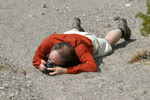
Yesterday (Sunday) two friends and I trekked out to the local desert (the southern part of the Anza-Borrego) in search of wildflowers. My friends Rick Pugh and Ted Dunning (seen at right) had been out in the desert before, but they had missed last year’s super-spectacular wildflower show. We knew it wouldn’t be as good this year as last; but we were at least hoping for a decent showing. In that we were disappointed — the flowers were as scarce as I’d ever seen them. To some extent I suspect that’s because we were a bit early; perhaps a week or two. But it’s more than that, as there were darned few green plants propoking up in most of the areas we trekked.

We drove out I-8 and turned north on S2 at Ocotillo. The ocotillos were in bloom, but only in a desultory fashion; nothing like years past. It’s possible that we were either too early or too late for them; there was so much individual variation that I couldn’t really tell. Other than the ocotillo, the first really nice flowers we saw were the chuparosa (Beloperone californica, at right), reliable as always — but still not as nice as in most past years.

Desert lavendar (Hyptis emoryi) is another one we spotted early in the day, down south of the Carizzo Badlands overlook. We were clearly too late for this one; those few plants that were still blooming at all had only a few blossoms left, right on the ends of their flower clusters. The bees were very attracted to the desert lavendar; every plant had dozens of bees feeding on it. The bee photo at right was one of 12 that I took of the same bee, all within a few seconds of each other — and it was the only one with the bee reasonably in focus. Those little guys move fast, and on top of that there was a light breeze making the branches sway — a nice photo challenge…

If I’m reading my field guide correctly, the flowers at right are Bigelow’s Monkey Flowers (Mimulus bigelovii), a figwort. These are the flowers that Ted is taking a photo of above; you can just barely make them out in the large version of the picture, a foot or so to the left of his camera. They are tiny! I took the rightmost photo by putting my camera right on the ground and aiming the lens in the general direction of the flower; I tried this three times before I managed to get the bloom framed. If I wanted to use the viewfinder, I would have needed to dig a hole for my chin! You can see the desolate micro-environment this individual was in, and according to the field guide that’s exactly what it likes: full sun, dry soil, and no competition.
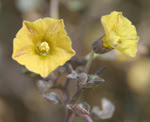

Here are a few I was unable to identify. If anyone knows what these are, I’d appreciate a comment with the ID. These were taken down on the Anza-Borrego desert floor, between Ocotillo and Smuggler’s Canyon (inclusive). I forgot to mention earlier that we had darned near perfect weather for this sort of an outing — very pleasant temperatures, relatively humid (compared to what the desert normally is!) thanks to the recent rains and the subsequent evaporation, and some diffuse lighting because of a variable, mostly light cloud cover. We seemed to have no trouble finding things to talk about, and laugh about, all day long; that always makes for a more enjoyable day.

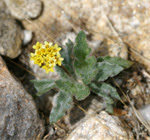
These are some others that I couldn’t identify, taken at higher altitudes at points along the Oriflamme Canyon jeep road, from the desert up to the top of the canyon. Just before we turned up the Oriflamme, we took a half-mile or so walk up Smuggler’s Canyon. That area is, in most years, prime wildflower territory; this year there was very little to see — though we just might have hit it a week or two too early. We got a nice surprise, though — the birding was better than I’d expected, given the dearth of flora. We were treated to several extended views of Lesser Goldfinches (Carduelis psaltria), with a behavior I’d never seen before — they were happily munching on the center flower parts of the ocotillos. We also saw another bird that I’ve been unable to identify from memory with my Sibley’s guide; I’m hoping Ted can pull that one out.
The rock-daisy (Perityle emoryi, far right) is usually quite abundant; this year we only saw a few plants (all southwards, between Carrizo Badlands and Ocotillo). This same area is where, in most years, I can find at least one or two desert lilies, which I just love. Not one this year; not only no bloom, but no plants, either. Their long leaves make distinctive, easy-to-spot rings in the sandy soil as the wind blows them around. We did spot a couple of gourds in a wash, and walked “upstream” until we spotted the plant’s remains from last year — with a bit of new growth just starting to show for this year.
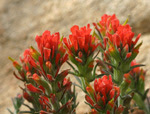

The two far-right photos are of the same Indian Paintbrush (Castilleja miniata); this was an individual with a particularly nice color, and handsomely set off against a rock, on the mesa between the top of Oriflamme Canyon and Banner. The Indian Paintbrushes vary considerably in color and form from individual-to-individual, and there are several varieties of them all living in the same area. I’ve never been able to tell the various red or reddish-orange ones apart. The group of cactus (I’m not sure which species this is) was a particularly good-looking bunch we stumbled across near the southwest end of Smuggler’s Canyon.
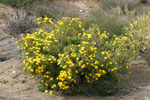

These last three photos are of a plant that Ted identified as a “bush poppy", and from what I’ve been able to find on the Internet, he’s correct: Dendromecon rigida, and to my surprise it really is a member of the poppy family (Papaveraceae) — and, happily, it’s a native. We’ve seen this plant in many places, but it is particularly abundant (and accessible, if you have a four-wheel drive vehicle) on the Banner half of the Oriflamme Canyon jeep road and the Rodriguez Canyon jeep road. When it’s set off against a shaded background, or against a dark rock, those yellow blossoms are spectacular — an almost unnaturally saturated and pure yellow. The little beetle seemed to enjoy the flowers as much as we did. The center photo shows a typical plant growing out on flat ground; in general I found the individuals on road cuts and steep grades to be more attractive, especially the foliage.
After we exited the jeep trail at Banner, we zoomed it up to Julian (saw a couple of ceanothus along the way), and south toward Cuyamaca. We stopped briefly at the vista point just south of Julian to eat a lunch that Ted had brought along (he sees such a meal as an aethetic requirement for an outing like this) — some nice gruyere cheese, salami, and a banana. We would have had chocolate to top it all off, but the mild heat down on the desert had completly liquified it. If that was my chocolate, I’d have found a way to pour it down my gullet — that liquification really just helps the mastication process with a little “pre-processing", as it were. But it was Ted’s chocolate, so I just watched — with some regret — as he put it away to take it home, and managed to control my sobbing over the loss…
As usual, click on any of the smaller pictures to see a larger version…





















